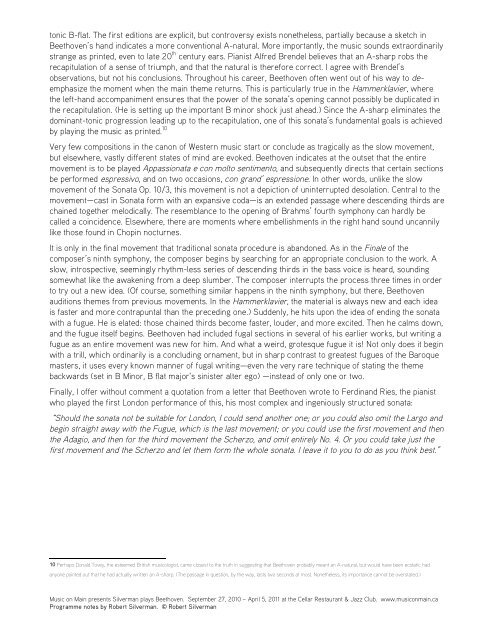beethoven's 32 piano sonatas robert silverman - Music on Main
beethoven's 32 piano sonatas robert silverman - Music on Main
beethoven's 32 piano sonatas robert silverman - Music on Main
Create successful ePaper yourself
Turn your PDF publications into a flip-book with our unique Google optimized e-Paper software.
t<strong>on</strong>ic B-flat. The first editi<strong>on</strong>s are explicit, but c<strong>on</strong>troversy exists n<strong>on</strong>etheless, partially because a sketch in<br />
Beethoven’s hand indicates a more c<strong>on</strong>venti<strong>on</strong>al A-natural. More importantly, the music sounds extraordinarily<br />
strange as printed, even to late 20 th century ears. Pianist Alfred Brendel believes that an A-sharp robs the<br />
recapitulati<strong>on</strong> of a sense of triumph, and that the natural is therefore correct. I agree with Brendel’s<br />
observati<strong>on</strong>s, but not his c<strong>on</strong>clusi<strong>on</strong>s. Throughout his career, Beethoven often went out of his way to deemphasize<br />
the moment when the main theme returns. This is particularly true in the Hammerklavier, where<br />
the left-hand accompaniment ensures that the power of the s<strong>on</strong>ata’s opening cannot possibly be duplicated in<br />
the recapitulati<strong>on</strong>. (He is setting up the important B minor shock just ahead.) Since the A-sharp eliminates the<br />
dominant-t<strong>on</strong>ic progressi<strong>on</strong> leading up to the recapitulati<strong>on</strong>, <strong>on</strong>e of this s<strong>on</strong>ata’s fundamental goals is achieved<br />
by playing the music as printed. 10<br />
Very few compositi<strong>on</strong>s in the can<strong>on</strong> of Western music start or c<strong>on</strong>clude as tragically as the slow movement,<br />
but elsewhere, vastly different states of mind are evoked. Beethoven indicates at the outset that the entire<br />
movement is to be played Appassi<strong>on</strong>ata e c<strong>on</strong> molto sentimento, and subsequently directs that certain secti<strong>on</strong>s<br />
be performed espressivo, and <strong>on</strong> two occasi<strong>on</strong>s, c<strong>on</strong> grand’ espressi<strong>on</strong>e. In other words, unlike the slow<br />
movement of the S<strong>on</strong>ata Op. 10/3, this movement is not a depicti<strong>on</strong> of uninterrupted desolati<strong>on</strong>. Central to the<br />
movement—cast in S<strong>on</strong>ata form with an expansive coda—is an extended passage where descending thirds are<br />
chained together melodically. The resemblance to the opening of Brahms’ fourth symph<strong>on</strong>y can hardly be<br />
called a coincidence. Elsewhere, there are moments where embellishments in the right hand sound uncannily<br />
like those found in Chopin nocturnes.<br />
It is <strong>on</strong>ly in the final movement that traditi<strong>on</strong>al s<strong>on</strong>ata procedure is aband<strong>on</strong>ed. As in the Finale of the<br />
composer’s ninth symph<strong>on</strong>y, the composer begins by searching for an appropriate c<strong>on</strong>clusi<strong>on</strong> to the work. A<br />
slow, introspective, seemingly rhythm-less series of descending thirds in the bass voice is heard, sounding<br />
somewhat like the awakening from a deep slumber. The composer interrupts the process three times in order<br />
to try out a new idea. (Of course, something similar happens in the ninth symph<strong>on</strong>y, but there, Beethoven<br />
auditi<strong>on</strong>s themes from previous movements. In the Hammerklavier, the material is always new and each idea<br />
is faster and more c<strong>on</strong>trapuntal than the preceding <strong>on</strong>e.) Suddenly, he hits up<strong>on</strong> the idea of ending the s<strong>on</strong>ata<br />
with a fugue. He is elated: those chained thirds become faster, louder, and more excited. Then he calms down,<br />
and the fugue itself begins. Beethoven had included fugal secti<strong>on</strong>s in several of his earlier works, but writing a<br />
fugue as an entire movement was new for him. And what a weird, grotesque fugue it is! Not <strong>on</strong>ly does it begin<br />
with a trill, which ordinarily is a c<strong>on</strong>cluding ornament, but in sharp c<strong>on</strong>trast to greatest fugues of the Baroque<br />
masters, it uses every known manner of fugal writing—even the very rare technique of stating the theme<br />
backwards (set in B Minor, B flat major's sinister alter ego) —instead of <strong>on</strong>ly <strong>on</strong>e or two.<br />
Finally, I offer without comment a quotati<strong>on</strong> from a letter that Beethoven wrote to Ferdinand Ries, the pianist<br />
who played the first L<strong>on</strong>d<strong>on</strong> performance of this, his most complex and ingeniously structured s<strong>on</strong>ata:<br />
“Should the s<strong>on</strong>ata not be suitable for L<strong>on</strong>d<strong>on</strong>, I could send another <strong>on</strong>e; or you could also omit the Largo and<br />
begin straight away with the Fugue, which is the last movement; or you could use the first movement and then<br />
the Adagio, and then for the third movement the Scherzo, and omit entirely No. 4. Or you could take just the<br />
first movement and the Scherzo and let them form the whole s<strong>on</strong>ata. I leave it to you to do as you think best.”<br />
10 Perhaps D<strong>on</strong>ald Tovey, the esteemed British musicologist, came closest to the truth in suggesting that Beethoven probably meant an A-natural, but would have been ecstatic had<br />
any<strong>on</strong>e pointed out that he had actually written an A-sharp. (The passage in questi<strong>on</strong>, by the way, lasts two sec<strong>on</strong>ds at most. N<strong>on</strong>etheless, its importance cannot be overstated.)<br />
<str<strong>on</strong>g>Music</str<strong>on</strong>g> <strong>on</strong> <strong>Main</strong> presents Silverman plays Beethoven. September 27, 2010 – April 5, 2011 at the Cellar Restaurant & Jazz Club. www.music<strong>on</strong>main.ca<br />
Programme notes by Robert Silverman. © Robert Silverman


